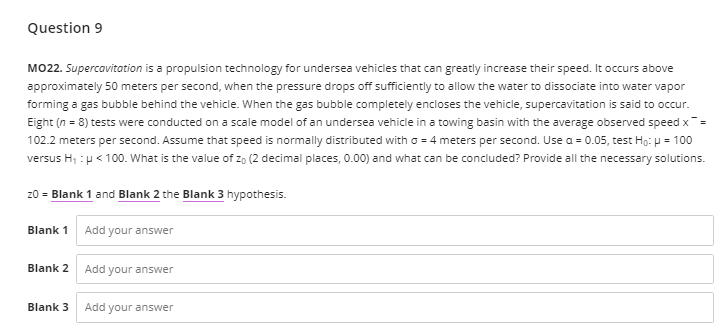Question 9 MO22. Supercavitation is a propulsion technology for undersea vehicles that can greatly increase their speed. It occurs above approximately 50 meters per second, when the pressure drops off sufficiently to allow the water to dissociate into water vapor forming a gas bubble behind the vehicle. When the gas bubble completely encloses the vehicle, supercavitation is said to occur. Eight (n = 8) tests were conducted on a scale model of an undersea vehicle in a towing basin with the average observed speed x = 102.2 meters per second. Assume that speed is normally distributed with o = 4 meters per second. Use a = 0.05, test Ho: p = 100 versus H, : p< 100. What is the value of z, (2 decimal places, 0.00) and what can be concluded? Provide all the necessary solutions. z0 = Blank 1 and Blank 2 the Blank 3 hypothesis. Blank 1 Add your answer Blank 2 Add your answer Blank 3 Add your answer
Question 9 MO22. Supercavitation is a propulsion technology for undersea vehicles that can greatly increase their speed. It occurs above approximately 50 meters per second, when the pressure drops off sufficiently to allow the water to dissociate into water vapor forming a gas bubble behind the vehicle. When the gas bubble completely encloses the vehicle, supercavitation is said to occur. Eight (n = 8) tests were conducted on a scale model of an undersea vehicle in a towing basin with the average observed speed x = 102.2 meters per second. Assume that speed is normally distributed with o = 4 meters per second. Use a = 0.05, test Ho: p = 100 versus H, : p< 100. What is the value of z, (2 decimal places, 0.00) and what can be concluded? Provide all the necessary solutions. z0 = Blank 1 and Blank 2 the Blank 3 hypothesis. Blank 1 Add your answer Blank 2 Add your answer Blank 3 Add your answer
Advanced Engineering Mathematics
10th Edition
ISBN:9780470458365
Author:Erwin Kreyszig
Publisher:Erwin Kreyszig
Chapter2: Second-order Linear Odes
Section: Chapter Questions
Problem 1RQ
Related questions
Question

Transcribed Image Text:Question 9
MO22. Supercavitation is a propulsion technology for undersea vehicles that can greatly increase their speed. It occurs above
approximately 50 meters per second, when the pressure drops off sufficiently to allow the water to dissociate into water vapor
forming a gas bubble behind the vehicle. When the gas bubble completely encloses the vehicle, supercavitation is said to occur.
Eight (n = 8) tests were conducted on a scale model of an undersea vehicle in a towing basin with the average observed speed x =
102.2 meters per second. Assume that speed is normally distributed with o = 4 meters per second. Use a = 0.05, test Ho: p = 100
versus H; : p< 100. What is the value of z, (2 decimal places, 0.00) and what can be concluded? Provide all the necessary solutions.
z0 = Blank 1 and Blank 2 the Blank 3 hypothesis.
Blank 1
Add your answer
Blank 2
Add
your answer
Blank 3
Add your answer
Expert Solution
This question has been solved!
Explore an expertly crafted, step-by-step solution for a thorough understanding of key concepts.
Step by step
Solved in 2 steps with 2 images

Recommended textbooks for you

Advanced Engineering Mathematics
Advanced Math
ISBN:
9780470458365
Author:
Erwin Kreyszig
Publisher:
Wiley, John & Sons, Incorporated

Numerical Methods for Engineers
Advanced Math
ISBN:
9780073397924
Author:
Steven C. Chapra Dr., Raymond P. Canale
Publisher:
McGraw-Hill Education

Introductory Mathematics for Engineering Applicat…
Advanced Math
ISBN:
9781118141809
Author:
Nathan Klingbeil
Publisher:
WILEY

Advanced Engineering Mathematics
Advanced Math
ISBN:
9780470458365
Author:
Erwin Kreyszig
Publisher:
Wiley, John & Sons, Incorporated

Numerical Methods for Engineers
Advanced Math
ISBN:
9780073397924
Author:
Steven C. Chapra Dr., Raymond P. Canale
Publisher:
McGraw-Hill Education

Introductory Mathematics for Engineering Applicat…
Advanced Math
ISBN:
9781118141809
Author:
Nathan Klingbeil
Publisher:
WILEY

Mathematics For Machine Technology
Advanced Math
ISBN:
9781337798310
Author:
Peterson, John.
Publisher:
Cengage Learning,

